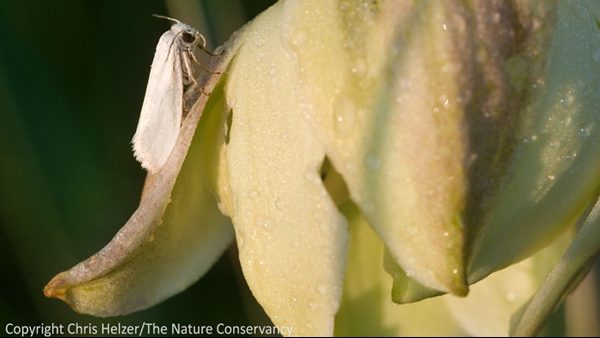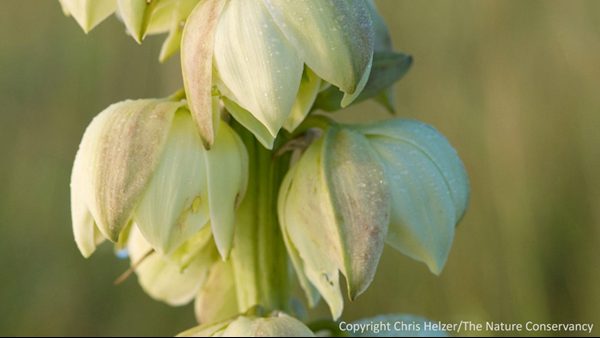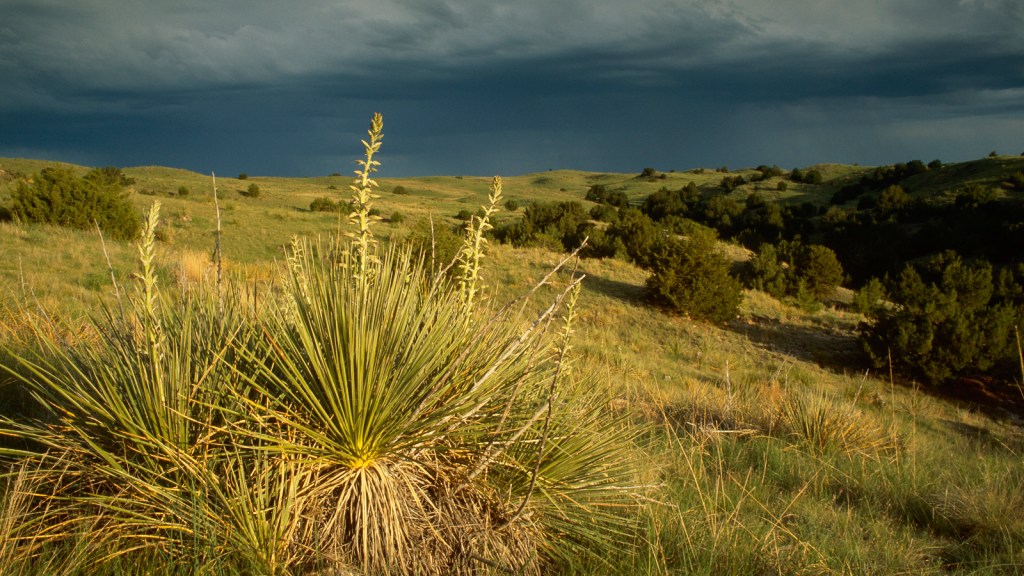For more than 40 million years there has been a relationship between yucca plants and yucca moths. It’s a particularly important one because neither the yucca or the moth can survive without the other. The moth’s larvae depend on the seeds of the yucca plant for food, and the yucca plant can only be pollinated by the yucca moth.
In the central United States, soapweed yucca (Yucca glauca) is pollinated by a moth known as Tegeticulla yuccasella. Each spring, adult moths emerge from underground cocoons and the males and females meet up with each other on yucca plants to mate.
When a female is ready to lay eggs, she first goes to a yucca flower to collect pollen. Unlike most moth species, yucca moths have two short tentacles near their mouth that they use to scrape pollen from the anthers of the flower. As she collects the sticky pollen, the yucca moth packs it into a ball and sticks it under her head. She then flies off to another yucca flower.

When she arrives at the second yucca flower, usually one that has very recently opened, she goes straight to the bottom to find the ovary. She opens a small hole in the ovary and lays her eggs inside.
Once the eggs are laid, she scrapes a small amount of pollen from her sticky ball with her tentacles, walks to the stigma of the flower, and packs the pollen into tiny depressions within the style.
She may then return to the ovary of the same flower to lay more eggs or fly to another flower. Either way, before she leaves the flower, she marks it with a pheromone (a chemical other moths can sense). The scent marker will tell later visitors that they’re not the first to reach the flower, and they will either lay fewer eggs than the first moth, or none at all, depending upon how many moths have left their scent already.
This helps moderate the number of larva that hatch within each flower, and prevents the plant from aborting the flower altogether, which it will do if too many eggs are laid.

When the eggs hatch, the larvae feed on yucca seeds within the fruit. Typically, there are more seeds than the larvae in a particular flower can eat (since the plant aborts flowers that are too heavily laden with eggs). When the larvae finish eating, they burrow out of the fruit—usually during rain events, interestingly—and burrow down into the ground to make their cocoon and wait until the next spring when the whole process plays out again.
As far as anyone knows, and it’s been studied since the 1870s, no other species besides the moth pollinates yucca flowers. Similarly, yucca moth larvae don’t feed on anything other than yucca seeds. So each species depends upon each other for survival, and both benefit from the relationship.
It’s a beautiful thing.
If you want to read about some additional interelationships with yucca, the moth, and other insects, you might be interested in this article by Laura Hebert.
Acknowledgments: Thank you to Mary Ann Feist for help with this post.
Read more of Chris Helzer’s writings at The Prairie Ecologist blog, where this post originally appeared.




Cool
The Yucca moths and the yucca plant help eachother out because only the yucca moth can polinate the yucca plant. The female yuccas fined a yucca plant and scrape off some pollin and then she will find another yucca plant and open it up and lay her eggs, and the pollin she takes can only be smelt by other yucca moths witch will tell them to either to lay fewer eggs or no eggs.
We live in england and have various flowering yucas in garden. One, in particular, has flowered for some years now and is flowering again – it now has three flowers .
another yuca is by our pond – that, too, is flowering – 2nd year.
am sure we , in england, will not have the yuca moths to polinate – and we have never polinated by hand, yet they are flowering very well !!!!!
pam
Do Yucca around Amarillo Texas need these same Moths?
I was born and raised in Amarillo. I’m currently in the high desert of Southern California. We ran across this interesting larvae (which we were unbeknownst to us a such). We simply wanted to see the innards of the fruit of the yucca plant, chopped it like a cucumber where we saw to our surprise little red ‘worms’ cruising around eating the seeds. OK our science followed that since there were no outside burrowing holes, and the fact that they almost immediately died in sunlight and or oxygen they hadn’t seen much of the outside world. So, logic would presume that they had never left that cavity and were in fact formed in there. At this point everyone kinda went back to their coffee/tea and it fell from mind.
ME? I interneted up. I would have never put together that they pupate into the only insect capable of pollinating said ‘host’. Thank you for this post, it filled in gaps.
Now back to Amarillo. My dear friend is a Master Gardener there and I had a small discussion with her as to Yucca as she was driving back from D.C. While she didn’t know much except to say that the Yucca population has gone down in the past years, and was also interested in the symbiosis of the whole thing. She did however say there’s someone locally you may want to talk to on the matter.
My gut tells me it’s not a geographic thing, but a species thing.
? story.. Beautiful phenomena of nature !❤️❤️
Cool but what type of symbiotic relationship is it
Hi Mia, I would say mutualism? What do you think? https://en.wikipedia.org/wiki/List_of_symbiotic_relationships
I had no clue that their was such thing as a yucca moth. I think it is neat how they have that.
it was a great help so thank you
since the plants are abort they are to heavily to lay eggs. And they lay eggs
Good thing I found this for my homework research
we are learning about symbiosis and I need to research the mutualistic relationship between the yucca plant and yucca moth. this is a great nature website. I’m sure I will visit in the future for science research
Thank you!
i think there sould be more information and i am doing a class project
The article is pretty informative for people who know little to nothing about the two species and thier symbiosis.
Sounds like romantic tale,the Yucca Plant has alot of fascinating aspects, the yucca known as actual meal among latin population it been substituted for potatoes,soups and even other meals
Is soapweed yucca (Yucca glauca) the only yucca species pollinated by a moth?
I’ve always found symbiotic relationships super interesting. It’s sort of amazing that if one became scarce or ceased to exist it would at the least a major impact on the other, and may even lead to extinction!
I wonder how long it would take for or other of the species to adapt if one did become scarce? And would they even be able to, or would both species just suffer?